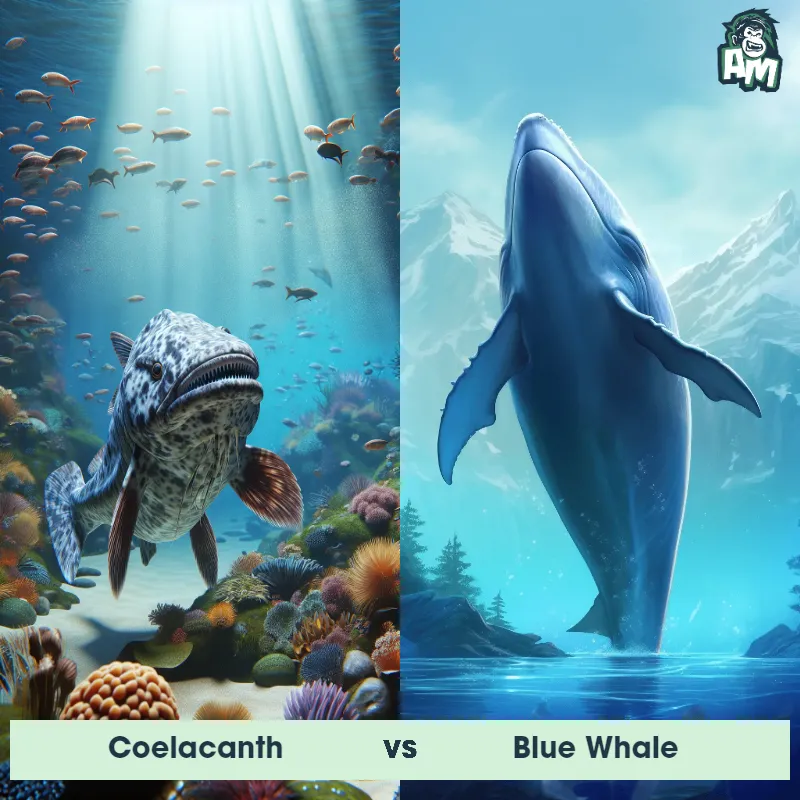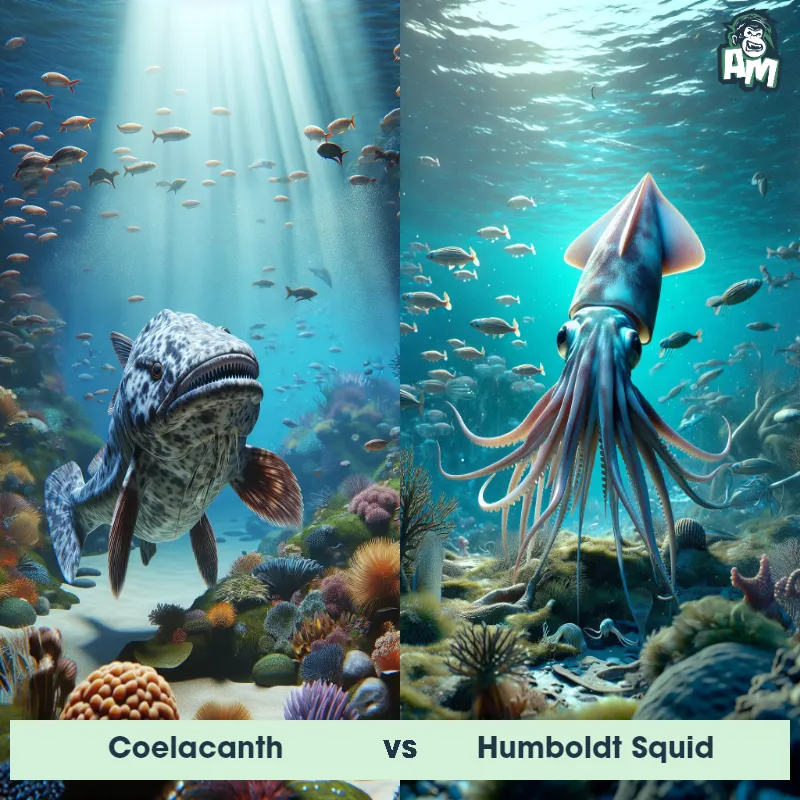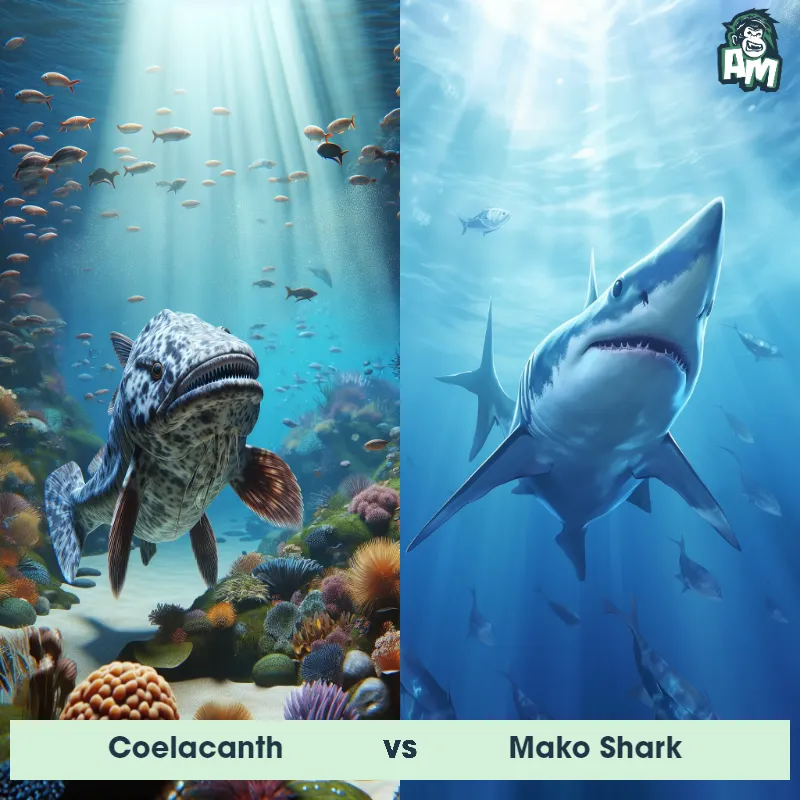The Coelacanth
The Coelacanth, also known as the "living fossil," is a prehistoric fish that has managed to survive for millions of years relatively unchanged. It has a distinctive appearance, with a lobed tail, paired lobed fins, and a series of thick scales called ganoid scales. Coelacanths can grow up to six feet long and have a bluish-gray or brownish coloration. They have a unique physiology, including a hinged skull, unique tooth structure, and a specialized organ called the rostral organ that allows them to detect electrical signals in the water.

| Coelacanth | |
|---|---|
| Size | 6 feet (1.8 meters) |
| Weight | 200 pounds (90 kilograms) |
| Speed | 0.5mph (0.8km/h) |
| Key Strength | Powerful jaws and sharp teeth |
| Biggest Weakness | Not specified |
| Scientific Name | Latimeria chalumnae |
| Family | Coelacanthidae |
| Habitat | Deep-sea |
| Geography | Indian Ocean |
| Diet | Small fish and cephalopods |
| Lifespan | 20 years - 30 years |

The Coelacanth
The Coelacanth, also known as the "living fossil," is a prehistoric fish that has managed to survive for millions of years relatively unchanged. It has a distinctive appearance, with a lobed tail, paired lobed fins, and a series of thick scales called ganoid scales. Coelacanths can grow up to six feet long and have a bluish-gray or brownish coloration. They have a unique physiology, including a hinged skull, unique tooth structure, and a specialized organ called the rostral organ that allows them to detect electrical signals in the water.
Fun Fact: The Coelacanth was thought to be extinct for over 65 million years until a live specimen was discovered off the coast of South Africa in 1938, making it one of the most exciting zoological discoveries of the 20th century.
| Coelacanth | |
|---|---|
| Size | 6 feet (1.8 meters) |
| Weight | 200 pounds (90 kilograms) |
| Speed | 0.5mph (0.8km/h) |
| Key Strength | Powerful jaws and sharp teeth |
| Biggest Weakness | Not specified |
| Scientific Name | Latimeria chalumnae |
| Family | Coelacanthidae |
| Habitat | Deep-sea |
| Geography | Indian Ocean |
| Diet | Small fish and cephalopods |
| Lifespan | 20 years - 30 years |
Coelacanth Matchups
We use AI to simulate matchups between the Coelacanth and other animals. Our simulation considers size, strength, and natural predatory behaviors to determine the most likely outcome.

Can't find the Matchup you want?
Create Your Own MatchupCoelacanth: Diet, Predators, Aggression, and Defensive Behaviors
What do Coelacanths eat?
Coelacanths are primarily piscivorous, meaning they primarily eat other fish. Their diet consists of various bony fish, crustaceans, and even cephalopods such as squid and octopus. They are known to be opportunistic feeders, feeding on whatever prey is available in their deep-sea habitats.
Do Coelacanths have any predators?
Due to their deep-sea habitat, Coelacanths do not have many natural predators. However, some potential predators include sharks such as the great white shark and the six-gill shark, as well as large predatory fish like groupers or barracudas. Human activities such as fishing and pollution also pose a threat to their populations.
Are Coelacanths aggressive?
Coelacanths are not considered aggressive towards other animals, including humans. They are elusive and shy creatures that tend to avoid contact with other species. They are not territorial and generally do not exhibit aggressive behavior towards other fish or marine animals.
Do Coelacanths fight?
Coelacanths are not known to engage in fighting behavior with other animals. They are solitary and slow-moving creatures that prefer to avoid conflict rather than engage in aggressive encounters. Their docile nature makes them unlikely to get involved in physical confrontations with other marine species.
How do Coelacanths defend themselves?
To defend themselves from potential threats, Coelacanths rely on their unique adaptations and camouflage abilities. Their coloration and shape help them blend in with their deep-sea surroundings, making them less visible to predators. They also have thick, bony scales that provide protection against attacks. Additionally, Coelacanths can quickly retreat to deeper waters to avoid danger.
What is the biggest weakness of Coelacanths in a fight?
Despite their unique adaptations and defensive mechanisms, the biggest weakness of Coelacanths in a fight is their slow swimming speed. They are not agile swimmers and rely on stealth and camouflage to avoid predators. This lack of speed and mobility can make them vulnerable to faster and more agile predators in a direct confrontation.
Fun Fact: Unlike most fish, the Coelacanth does not have a swim bladder, which is a gas-filled sac that helps other fish control their buoyancy. Instead, the Coelacanth relies on its paired lobed fins and its muscular tail to navigate and stay afloat in the water.
Fun Fact: The Coelacanth has unique adaptations that allow it to survive in deep-sea habitats, such as specialized fins that can be used for walking on the ocean floor and large, fatty pectoral fins that enable it to glide through the water with minimal effort.













